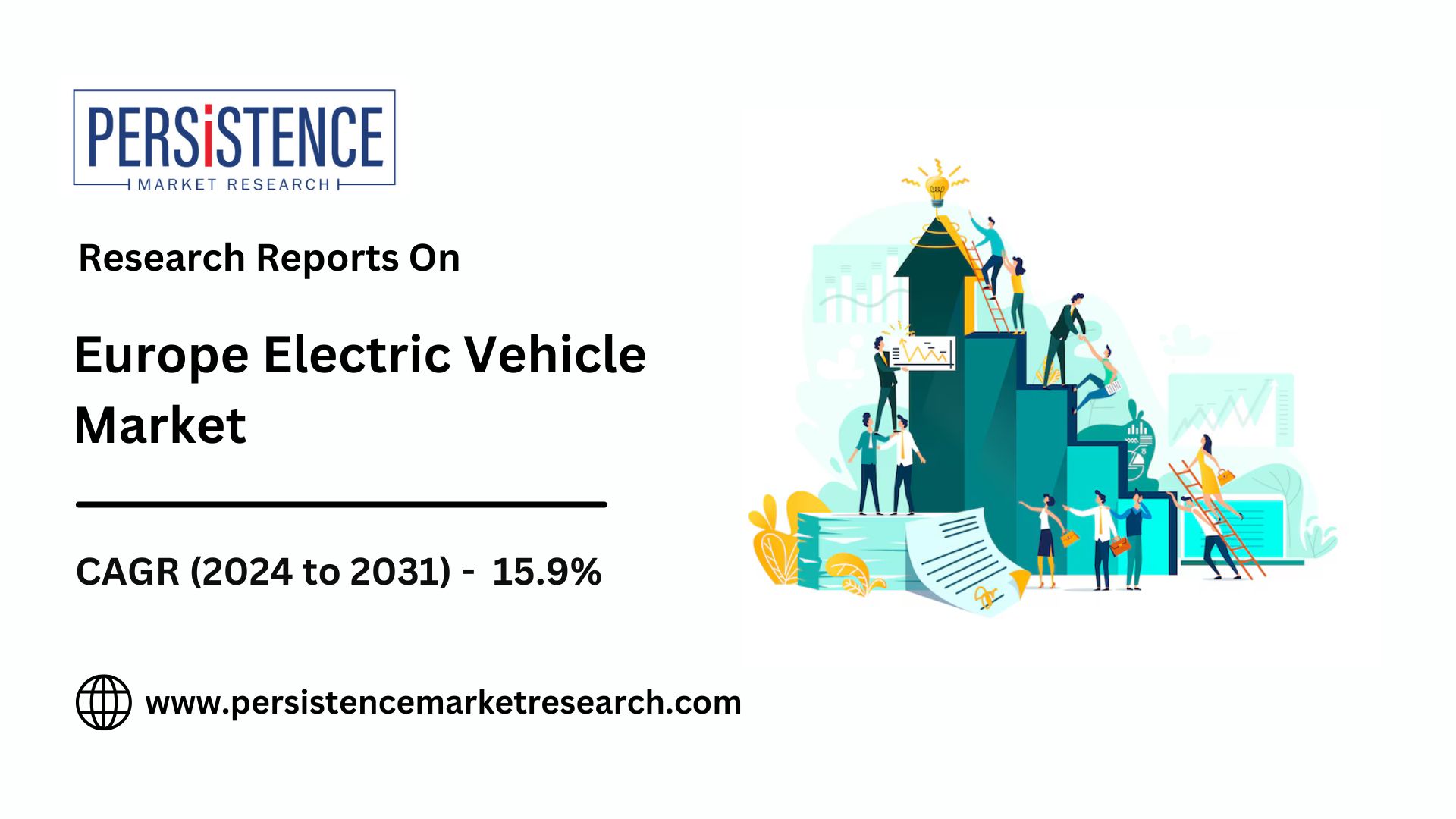Europe’s EV Transformation: Advancements in Charging and Battery Tech Fuel Growth

Strong 8k brings an ultra-HD IPTV experience to your living room and your pocket.
The Europe electric vehicle (EV) market is set to experience significant growth, with an estimated market value of US$489.3 billion by 2031, up from US$174.2 billion in 2024. This growth is driven by advancements in battery technology, the integration of vehicle-to-grid systems, and the expansion of ultra-fast charging infrastructure. The market is projected to grow at a robust CAGR of 15.9% from 2024 to 2031. Germany leads the market, followed closely by the U.K., with both countries projected to secure impressive CAGRs of 15.2% and 16.3%, respectively. The passenger vehicle segment is expected to dominate, while the 301 to 500 km range EVs show strong potential for growth.
The electric vehicle (EV) market in Europe is witnessing rapid growth, driven by significant advancements in charging infrastructure and battery technology. With environmental concerns and regulatory pressures pushing the adoption of cleaner, more sustainable transportation solutions, Europe is becoming a key player in the global EV revolution. This transformation is not only reshaping the automotive industry but also paving the way for a more sustainable future. In this article, we explore how innovations in charging and battery technology are accelerating the shift towards electric mobility in Europe.
The Growing Demand for Electric Vehicles in Europe
Europe’s commitment to reducing carbon emissions and combating climate change has played a pivotal role in boosting the demand for electric vehicles. The European Union (EU) has set ambitious targets to become carbon-neutral by 2050, and EV adoption is central to this vision. As governments across the continent introduce stricter emissions regulations and offer substantial incentives for EV buyers, consumer interest in electric vehicles continues to rise.
In 2023 alone, Europe saw a record increase in EV sales, with electric cars accounting for nearly 20% of all new car registrations. The growing awareness of the environmental benefits of EVs, combined with the rising cost of traditional gasoline and diesel vehicles, has encouraged more consumers to make the switch to electric.
Revolutionizing Charging Infrastructure Across Europe
One of the key factors influencing the growth of the electric vehicle market in Europe is the significant investment in charging infrastructure. Reliable and widespread charging stations are essential to overcoming one of the biggest hurdles for EV adoption—range anxiety. Drivers need to be confident that they can find charging points easily and that these stations are fast, reliable, and accessible.
European governments and private companies have responded by expanding and upgrading the EV charging network. The EU has invested heavily in public charging infrastructure, aiming to build over 1 million public charging points by 2030. This initiative is part of a broader strategy to create a seamless, interconnected EV ecosystem that ensures drivers have access to a convenient and efficient charging experience across the continent.
In addition to public charging points, home charging solutions are becoming increasingly popular, offering convenience and cost savings for EV owners. Several innovative companies are developing advanced home chargers that enable faster charging times, making it easier for consumers to maintain their EVs without relying on public stations.
Fast Charging: The Key to Enhancing EV Convenience
As electric vehicle adoption grows, the demand for fast-charging solutions has surged. Traditional EV chargers can take several hours to fully charge a vehicle, but with the rise of fast chargers, the charging process is becoming significantly quicker and more convenient.
In Europe, several companies are investing in ultra-fast charging networks that can replenish an EV’s battery to 80% in just 20 minutes. These advancements are particularly important for long-distance travel, as they reduce the time spent at charging stations and make EVs a more viable option for everyday use, even for those who need to drive longer distances.
Fast-charging stations are also being strategically placed along major highways and in city centers to provide easy access to high-speed charging. By reducing the charging time and improving station accessibility, Europe is making EVs a more practical and attractive choice for consumers.
Battery Technology: The Backbone of the EV Revolution
While charging infrastructure is essential, the development of advanced battery technology is at the heart of Europe’s electric vehicle transformation. The efficiency, range, and cost of EV batteries have improved significantly over the past few years, addressing several barriers to EV adoption.
In particular, European companies are making significant strides in developing next-generation lithium-ion batteries and exploring alternative battery chemistries. These advancements are aimed at increasing energy density, reducing charging times, and lowering costs. As a result, EVs are becoming more affordable, with improved performance and longer ranges.
Another critical area of development is solid-state batteries, which have the potential to revolutionize the electric vehicle industry. These batteries are more energy-dense, safer, and longer-lasting than traditional lithium-ion batteries. Several European companies and research institutions are leading the charge in the development of solid-state battery technology, with hopes that these innovations will become mainstream in the coming decade.
European Automakers Leading the Charge
The role of European automakers in the EV transformation cannot be overstated. Companies like Volkswagen, BMW, and Renault are investing billions of euros in electric vehicle development and production. These manufacturers are not only shifting their focus towards electric cars but are also collaborating with tech firms to enhance their vehicles with cutting-edge software and charging solutions.
Volkswagen, for instance, has announced plans to become the world’s leading electric vehicle manufacturer by 2030. Its ID series of electric vehicles, which range from compact cars to larger SUVs, has received positive feedback from both consumers and industry experts. Other companies, such as Mercedes-Benz and BMW, are also introducing a growing range of electric models, ensuring that consumers have a broad selection of options.
Moreover, European automakers are working together to establish common charging standards and develop better charging networks. This cooperation helps standardize the EV charging experience across the continent, making it easier for consumers to navigate the growing EV infrastructure.
The Role of Government Policy in Accelerating EV Adoption
Government policies across Europe have been instrumental in accelerating the transition to electric mobility. Subsidies, tax breaks, and grants for EV buyers have made electric cars more affordable, while stringent emissions regulations have pushed automakers to accelerate their shift towards EVs.
For instance, several European countries, including Norway, France, and the Netherlands, offer generous incentives for EV purchasers, such as tax rebates and reduced registration fees. These initiatives have helped lower the cost of electric vehicles, making them more accessible to a broader range of consumers.
At the EU level, the European Commission has introduced several legislative measures aimed at promoting clean mobility. The EU’s “Green Deal” includes plans to phase out the sale of new internal combustion engine vehicles by 2035, which will further encourage the shift to electric vehicles.
The Future of Electric Vehicles in Europe
As Europe continues to invest in charging infrastructure, battery technology, and government incentives, the future of electric vehicles looks bright. By 2030, it is expected that EVs will account for more than 50% of all new car sales in Europe, marking a significant shift towards a more sustainable and eco-friendly transportation system.
The rise of autonomous electric vehicles and the integration of artificial intelligence (AI) will further revolutionize the EV landscape. Self-driving EVs have the potential to reduce traffic congestion, improve safety, and lower transportation costs. European companies are at the forefront of developing autonomous EVs, making Europe a global leader in both electric and self-driving technologies.
With the continued advancements in charging and battery technologies, as well as supportive government policies, Europe is well on its way to achieving its vision of becoming the world’s leader in electric mobility. The future of transportation is electric, and Europe is driving the charge.
Conclusion
Europe’s electric vehicle revolution is a testament to the region’s commitment to sustainability, innovation, and technological advancement. As charging infrastructure expands and battery technology improves, the EV market will continue to thrive. By embracing these innovations, Europe is not only transforming the automotive industry but also paving the way for a greener, cleaner future. With continued investments in technology, policy, and infrastructure, Europe is poised to lead the global shift towards electric mobility.
Note: IndiBlogHub features both user-submitted and editorial content. We do not verify third-party contributions. Read our Disclaimer and Privacy Policyfor details.







